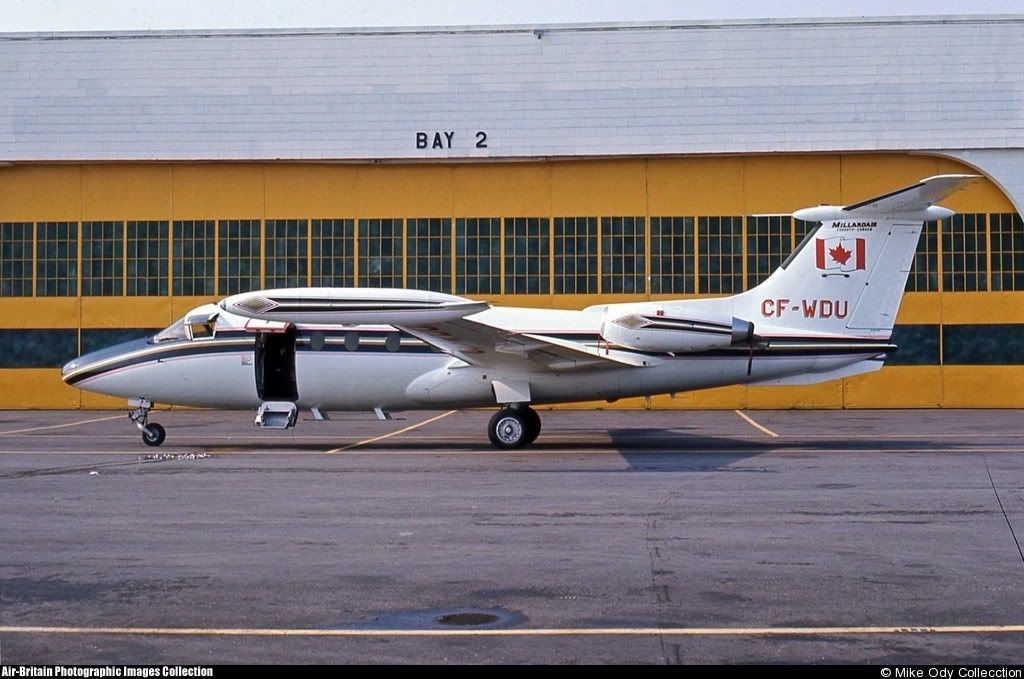Found these interesting;
Article from Wings Magazine
from the article, 'In 1961 Millard set the airport on notice that he was playing for the long term when he purchased the old Toronto Flying Club hangars and had them moved to what became known as the ‘North Side’ of the airport. “Because of the size of the hangars, we had to move them across the airfield. The roads certainly would not do and even the runways were not big enough. Some of the trucks and wheel sets actually ran off the hard ground onto the grass and we broke at least one axle. Regardless, once we started the move we had to continue until we cleared the active flight areas.” Carl also noted that once the hangars were moved to the north end, they set the new foundations five feet higher above the ground than they were before to provide clearance for larger aircraft.'
Caz Caswell and Douglas Holland Add:
The History of Millardair is inseparable from its owner, CEO and President, Carl Millard was born in November 1913 and died in November 2006, at 93.
Carl Millard was born to fly and his last flight was in his own Cessna Citation when he was 85. The flight was a check to renew his instrument rating, which he passed!. He was within the confines of his own ambition a successful Business Man also he neither 'suffered fools, or officialdom gladly'. `
This meant his relationship with Transport Canada was at best one of an uneasy truce, but with periods of what can only be described as open defiance. `
Sometimes this led to a 'slap on the wrist' but finally the deteriorating relationship between Transport Canada and Carl Millard was one of the primary reasons why Millardair was forced to cease Airline Operations. With Carl sighting 'Excessive Red Tape'. Millardair remained in business providing Hangarage Services.
Up to a couple of Months before his death, Carl retained an interest in the Business (which was now run by his sone Wayne).
There are lot of stories about Carl Millard both as a Pilot and his 'hobby of butting of heads' with Transport Canada. But it is as an outstanding pilot he should be remembered and the first to 'dead-stick land' a Commercial Jet.
To summarise this incident: - Carl was flying a Hansa Jet between St John's and Toronto with 10 Passengers on a Night Flight in December 1973. The Aircraft was in cruise overhead Moncton when both engines failed (later found to be contaminated fuel).
The now gliding Hansa Jet entered Cloud at 30,000 feet and only broke through the cloud base at a mere 200 feet above the ground, but in snow. Despite these cumulative problems. due to Carl's skill the Hansa Jet was lined up with the runway at Moncton Airport as it broke cloud, with the result that the Aircraft made a safe landing!
and
The following are short quotes on what was written by Bill Taylor, of the Toronto Star:
It wasn't that Carl Millard was a curmudgeon "but he realized you couldn't be a wimp and run an airline," says aviation author and publisher Larry Milberry. "He had his own way of doing things. Not everybody loved him but they were the ones who couldn't meet his standards.
Millard was born at his father's farm near Ingersoll, Ont., Nov. 28, 1913, only 10 years after the Wright brothers first flew. At 15, he was inspired to fly when a bright-red plane flew over the field he was ploughing. Terence Tully and James Medcalfe were trying to make the first flight from London, Ont., to London, England. They disappeared in mid-Atlantic but they'd sown a seed in Millard's mind.
He bought and rebuilt a dilapidated plane and was taught to fly by a former World War I fighter pilot.
Millard was the 46th pilot hired by Trans-Canada Airlines, the forerunner of Air Canada. He formed his own company, Millardair, in 1963, with a fleet of 20 aircraft. He also built a reputation for butting heads with Transport Canada over the aging DC3 and DC4 propeller-driven cargo planes he insisted on flying right into the jet age.
The young pilots and mechanics hired by Millard didn't earn much money at first. If they couldn't afford lodgings, they'd bunk down in the hangar.
"His love was 'piston-pounding'-planes," said Milberry. "Flying was in his bones. It wasn't just a job. These old planes were as safe as anything else but Transport Canada was always on his case. It was an ongoing dogfight but Carl beat them."
His son Wayne recalled two Royal Canadian Air Force DC3s being sold in Scotland in the 1960s. "Dad figured they were worth $75,000 each. But he said, 'I'll bid $25,000 each and hope everyone else is scared to fly the Atlantic in them.' It worked! The two of us brought them back, refuelling in Iceland and Greenland. They became the backbone of the business."
The airline still exists in name but hasn't flown in about 10 years, Wayne said.
"We own the hangars and Dad decided there was more money in being in the hangarage business. Up to a few months ago, he was coming in every day for a couple of hours, just to make sure everything was running right."






